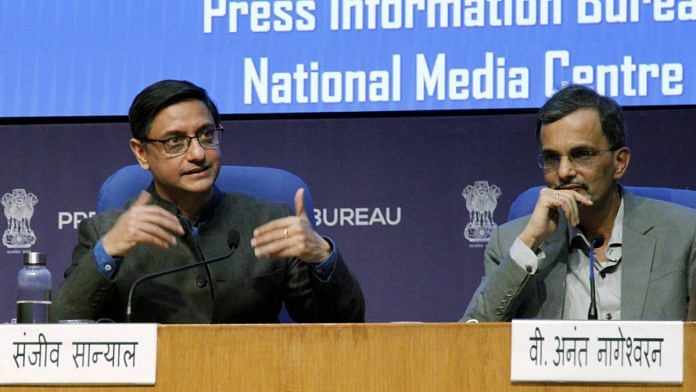New Delhi: There is a need to be concerned about imported inflation, especially that arising from a rise in global energy prices and supply disruptions, Principal Economic Adviser Sanjeev Sanyal said Monday.
He was speaking at a media briefing after the release of the Economic Survey 2021-22.
Sanyal, who along with his team, has compiled the Economic Survey, said that while these disruptions have caused an increase in headline retail inflation (that reported through the Consumer Price Index), it has largely remained within the tolerance band of the Reserve Bank of India (RBI).
The government has mandated the RBI to maintain inflation based on the Consumer Price Index (CPI) within a tolerance band of two to six per cent, with four per cent as the medium term inflation target. The target has been set for a period of five years, till March 2026.
“Since things have opened up this year, you saw the CPI come back into the tolerance band and it remains within the band as of the latest reading of 5.6 per cent. But WPI (Wholesale Price Index) has popped back up and is in double digits. Some of this is the reflection from the low base of last year, so that will wear itself out. But here in India we need to be concerned about imported inflation,” Sanyal said.
On the government’s focus on capital spending, the newly-appointed Chief Economic Adviser, V. Anantha Nageswaran, said that high capital expenditure by the central government and the states during the past year would lead to more employment generation.
Also read: Economic Survey goes through ‘great deal of evolution over the years’
Factors for high wholesale price inflation
CPI inflation surged to a five-month high of 5.6 per cent in December, primarily on account of the statistical effect of a low base. It was 4.91 per cent a month ago. With this, CPI inflation has averaged five per cent for the October-December period, marginally below the RBI’s forecast of 5.1 per cent.
Wholesale price inflation, however, has been running in double-digits. A surge in energy prices, non-food commodities, input prices, disruption of global supply chains, as well as rising freight costs stoked global inflation during the year, the Economic Survey noted. Moreover, an increase in demand due to revival in economic activity and large fiscal spending pushed up inflation in advanced as well as emerging economies.
A particularly sharp rise was witnessed in global crude oil prices, which have climbed nearly 40 per cent so far in 2021-22, increasing the price of India’s crude oil basket by nearly $25 a barrel during the period. The rise in oil prices was exacerbated by supply cuts by the Organization of the Petroleum Exporting Countries (OPEC) and its allies.
The price of India’s crude oil basket hit a fresh seven-year high of $88.85 per barrel Friday — the highest level since October 2014, according to data from the Petroleum Planning and Analysis Cell.
High capital spending to create more jobs
Anantha Nageswaran, said that both the central government and the states have been spending heavily on capital generation.
He said the states have increased their capital spending by 67 per cent in the April-November period as against the same period last year.
States have a capital spending target of Rs 5.79 lakh crore in 2021-22, while the Centre has a target of Rs 5.54 lakh crore on capital spending, an increase of 34.5 per cent over last year.
“State governments spending on capex (Capital expenditure) has gone up by 67 per cent in April to November. Governments have frontloaded growth and that would lead to crowding in of the private sector, which in turn would lead to job growth,” Nageswaran told reporters.
The central government’s capital spending in April-December has risen 26.8 per cent from the same period last year to Rs 3.92 trillion, accounting for 70.7 per cent of the full year’s target.
Higher capital expenditure in the infrastructure sector ramped up the construction sector and allowed consumption and production to pre-Covid levels, the Economic Survey said.
(Edited by Saikat Niyogi)
Also read: Economic Survey forecasts 8-8.5% GDP growth in 2022-23, below IMF projection of 9%



